Orange Juice
Your
quarterly
vitamin.
Written on 04/13/16 1:55 AM
What is Programmatic Advertising?
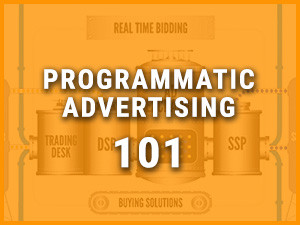 Programmatic is the automation of buying and selling digital advertising inventory, including real-time bidding (RTB), that has seen tremendous growth over the past five years. It has started to transform how we buy and sell ad inventory. While RTB has historically been associated with remnant inventory, this technology is now increasingly being applied to a wider range of inventory. There has been confusion in the marketplace over terminology with a number of terms being used interchangeably such as: “programmatic,” “programmatic direct,” “programmatic premium,” “programmatic guaranteed,” and “automation”. Many definitions abound and they vary from site to site and from partner to partner. Additionally, marketers are bombarded with a lot of acronyms when referring to Programmatic, for example RTB, DSP, DMP, SSP, and many more. We will attempt to decipher and provide definitions for many of these key terms.
Programmatic is the automation of buying and selling digital advertising inventory, including real-time bidding (RTB), that has seen tremendous growth over the past five years. It has started to transform how we buy and sell ad inventory. While RTB has historically been associated with remnant inventory, this technology is now increasingly being applied to a wider range of inventory. There has been confusion in the marketplace over terminology with a number of terms being used interchangeably such as: “programmatic,” “programmatic direct,” “programmatic premium,” “programmatic guaranteed,” and “automation”. Many definitions abound and they vary from site to site and from partner to partner. Additionally, marketers are bombarded with a lot of acronyms when referring to Programmatic, for example RTB, DSP, DMP, SSP, and many more. We will attempt to decipher and provide definitions for many of these key terms.
In simplistic terms, another word for Programmatic is Audience Buying because that this is essentially what advertisers are purchasing:
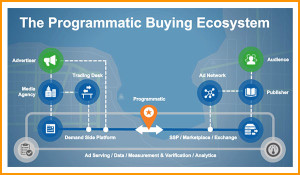 instead of placements, they are purchasing Audiences regardless of where they may be browsing or surfing. The inventory is bought using algorithms, AI (artificial intelligence) and automated trading/bidding systems. At the core of Programmatic is the Ad Exchanges; they aggregate digital ad inventory from millions of sites and operate very much like a Stock Exchange. We’ll explore that in a later section.
instead of placements, they are purchasing Audiences regardless of where they may be browsing or surfing. The inventory is bought using algorithms, AI (artificial intelligence) and automated trading/bidding systems. At the core of Programmatic is the Ad Exchanges; they aggregate digital ad inventory from millions of sites and operate very much like a Stock Exchange. We’ll explore that in a later section.
The below graphic gives on overview of how programmatic is structured from the media agency side as well as the publisher side. Programmatic sits in the middle and makes decisions in real time as to how the inventory is bought and sold.
Why do we need Programmatic?
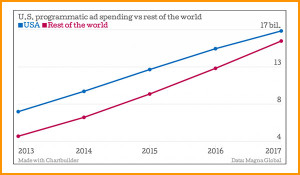 With programmatic buying, advertisers have access to vast amounts of inventory, data, and targeting options. According to eMarketer, by 2017 83% of all display ad buys will be purchased programmatically. Magna Global predicts that US programmatic ad spending will hit $17 Billion by 2017.
With programmatic buying, advertisers have access to vast amounts of inventory, data, and targeting options. According to eMarketer, by 2017 83% of all display ad buys will be purchased programmatically. Magna Global predicts that US programmatic ad spending will hit $17 Billion by 2017.
Programmatic buying allows advertisers to target audiences in a multitude of different ways, below are the main options for targeting display, mobile or video ads:
In the future, most buying will be done via programmatic; not only for display ads but also for video, TV, audio, social and native. Buying in this manner actually saves money because of the efficiencies brought about by automation. However, costs can quickly escalate the more vendors and technology companies that enter into the mix. Each will get a cut of costs which can quickly add up.
The advantages are:
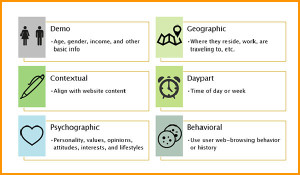
-
Economic Efficiency
-
Targeting
-
Organizational Efficiency
-
Measurement
-
Transparency
How does it work?
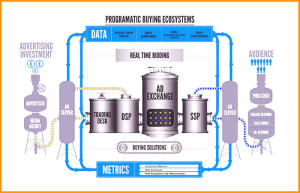
At the core of Programmatic is the Ad Exchange. Similar to the stock market, ad inventory on the Exchange is placed into a bid auction system where advertisers can bid on ads based on location, demographics, psychographics and a range of other criteria. The inventory options that are available go far beyond display ads including: Video, Mobile, Native, Social and Audio.
The graphic below demonstrates how all of these platforms and systems work together in a complex ecosystem that operates within milliseconds of an ad being delivered to a users screen. Both agencies and publishers are feeding in buys and inventory on either side. In the middle stands a system of Trading Desks (owned by agency holding companies), DSP’s (Demand Side Platforms), Ad Exchanges, Data Providers and Management Platforms (1st party and 3rd party), and SSP’s (Supply Side Platforms).
Definitions:
Trading Desk: large agency holding companies that have their own programmatic buyers that purchase directly from the Exchanges for their list of clients.
DSP (Demand Side Platform): enables advertisers to purchase ad inventory via RTB exchanges (examples are MediaMath, Turn, Invite Media, The Trade Desk)
Ad Exchange: a digital marketplace that enables advertisers and publishers to buy and sell advertising space, often through real-time auctions (Doubleclick, AppNexus, OpenX)
SSP (Supply Side Platform): a technology platform that enables web publishers to manage their advertising space inventory, fill it with ads, and receive revenue
DMP (Data Management Platform): provides the function of data collection, translation, classification, indexing and storage. In simple terms the ‘plumbing’ part of data-driven marketing online. (Oracle BlueKai, Neustar, Aggregate Knowledge)
Data Usage:
Programmatic buying allows the inclusion of many data sources to inform targeting and optimization decisions. It allows the buyer to show one ad impression to one anonymous viewer in one context. In the current programmatic landscape, the most common data used is leveraged on the buy side. Buyers layer both third-party data, as well as advertiser first-party data, onto campaigns. In addition, some publishers offer their first-party data.
Protecting against Fraud
Industry research has shown that an average of 55% of all digital display ads are not seen at all. This could be due to many factors: ad is below-the-fold and the user did not see it, fraudulent non-human traffic that comes through from bots or other computer programs.
Moving toward Viewability is RPM’s #1 priority moving forward and we are setting up systems to ensure that all of our advertisers are getting the highest percent of viewable impressions. Verification companies including 3rd party ad servers have viewability measurement built in to measure whether an ad is viewable or not on desktops or PCs. Mobile measurement will follow shortly but is not ready for primetime.
More and more high quality inventory is being made available programmatically like private marketplaces and publisher direct. By accessing this inventory, we can improve the quality of our ad placements and also improve viewability.
Programmatic Vendors
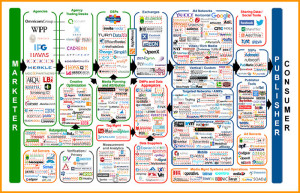
As you can see by the below Lumascape chart, there are an enormous number of players in the Ad Tech space. More come to market every day and also get acquired by other companies or change business models. Keeping up with the rate of change is very challenging, however, RPM keeps abreast of these changes by attending industry events, researching technologies and scheduling regular vendor meetings.
How is it Measured?
Programmatic buying can be purchased in different ways depending on campaigns goals. Below are the most common goal and cost structures:
-
Awareness: CPM or Cost-per-Thousand (used most frequently)
-
Performance: CTR (click-through rate), CPA (cost-per-acquisition), CPL (cost-per-lead), ROI
-
Viewability metrics by the 3MS (MRC, IAB, ANA and 4A’s) have established the following measurement standards to assess whether an ad is viewable:
-
Display: 50% of ad pixels must be viewable on desktop/PC for 1 continuous second
-
Video: 50% of ad pixels must be viewable on desktop/PC for 2 continuous seconds
-
Mobile: Viewable Impressions guidelines are currently being decided upon
Recommendation
Due to the enormous amount of inventory and opportunities Programmatic has to offer, it is an area for growth and exploration for all PNG properties. RPM is already working with Programmatic partners and has begun testing these vendors to determine reliability, volume and performance. We will continue to test new DSP partners to determine which ones fit our needs and comply with our quality standards. RPM is researching future opportunities for establishing its own trading desk using the latest technology with 100% transparency while also ensuring the highest quality inventory.
Next Steps
-
Viewability Approach
-
Determine and test new Programmatic partners
-
Share goals and objectives with new partner
-
Implementation
-
Shared Analytics
-
Evaluation
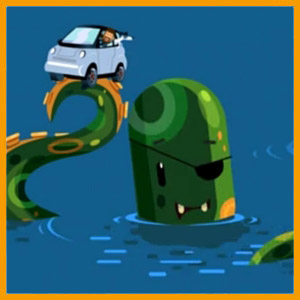
Not sure if you’ve been in a new car lately but driving one seems more akin to piloting the Millennium Falcon than any of the cars of our collective youth. Yes, there’s a steering wheel and a seat and a dashboard in simple terms.
But look closely. The steering wheel is a literal command center that has hardly anything to do with directing the car. Dashboards now come with operating instructions. You heard right, operating instructions.
Kidding aside, there’s so much about new cars that’s just amazing. They can park themselves, tell you where to go, and call you when it’s time for an oil change. Cars now have sensors for well, everything. A mechanic can plug into your car’s computer system and pinpoint any malfunction, no matter how tiny. And the new safety features on these cars? Wow.
Cars can now adjust your cruising speed based on the distance between you and the cars around you. They can brake for you if say, you’re fiddling with the cool sound-system and not watching the road. Backup cameras will alert you to unseen dangers, and on and on.
As great as it all is, the National Safety Council found that people may be relying on these systems a little too heavily. After all, if you know your car’s going to warn you of any impending doom, why would you pay real attention yourself?
A new website, MyCarDoesWhat.org highlights many of the new features that cars offer today. More importantly, it aims to educate drivers on how to be safe on the road.
When RPM Advertising pitched the business, it was clear that along with traditional media such as television and outdoor, digital media could vastly increase the chances of accomplishing the brand’s communication objectives. In order to influence and improve the driving public’s relationship with all the new automotive safety technologies, everything hinged on getting people to the website.
So instead of scolding bad driving habits or being too factual or informational, the idea was to disarm people and entice them with a wildly fun and irreverent online campaign.
Using a playful animation style and an incredibly infectious melody, the team at RPM wanted to get people singing along and sharing the video with friends. In time, the viral quality of the communication would be its major strength, creating a groundswell of interest and intrigue.
Although there are no fender benders or distracted drivers, the video uses metaphors such as ninja attackers and one-eyed Krakens to highlight all the crazy things that confront us on the road. The simple truth is that human beings are always the greatest safety feature in any car. And the new video from RPM aims to get the word out at the speed of the Internet. In the end, RPM was not awarded the business. However, the team remains proud of the strategy & creativity of the work presented including the online video, “Crazy World.”
Crazy World commercial from rpmadv on Vimeo. It’s been said that creativity is finding two unrelated things and putting them together. If that’s true, the more unrelated things you experience, the better your chances of finding those two things in the first place.
It’s been said that creativity is finding two unrelated things and putting them together. If that’s true, the more unrelated things you experience, the better your chances of finding those two things in the first place.
For sure, creativity is a funny thing. Even though there’s been tons of research and scientific dabbling into the creative mind, there’s no concrete answer as to why some people are more creative than others. There’s no evidence of a creative gene, so to speak.
But there are similarities or traits that these people share. This isn’t about people who happen to work in a so-named creative department. Because creativity is not reserved for some people. It’s not confined by what you do for a living or whether or not you possess certain artistic talents.
Creativity is everywhere. It can be anything. It can show up in a clever interpretation of the tax code or last night’s exotic casserole. That’s because creativity is a way of living your life. It’s a way of doing things. A unique perspective.
True creativity is the art of being curious.
So the goal of any organization or business should be to find these curious people. To fill out the roster with men and women who possess that never-ending sense of wonder and discovery. People who ponder the possibilities. Who like to tinker and dig. The ones who wander the psychic landscape and question the world at large.
These are the kind of people who get engrossed in science shows about the trade winds in Upper Mongolia. They’re fascinated by stories of ants that have somehow made a home on the 103rd floor of the Empire State Building. They search, they daydream and stare up at the night sky.
Because these are the people who will most likely find a cure for cancer. They’re the ones who put two and two together and find the formula for time travel.
In short, these are the people who see things differently than the rest. They bring a unique perspective and find new ways of doing things. They don’t want to tread on well-worn paths, they search for a new way through. More importantly, they’re extraordinarily keen to the odd occurrences and unforeseen opportunities that ultimately lead to our biggest breakthroughs.
Does the company president who runs to Michigan to cultivate a small farm make him more eager to grow the talent at his company rather than buying it out in the marketplace?
What about a media director who spends her precious time off searching the stars and planets as an amateur astronomer? Would that enhance her abilities to search the media landscape for the next great opportunity?
There are mail room guys who dabble in the stock market. CEO’s who spend their time making documentaries. Digital planners who build children’s playgrounds, rock ‘n roll accountants, IT racecar drivers, and on and on.
People who are curious about their world, who have hobbies and passions bring so much more to their everyday responsibilities. And the businesses where these people work will undoubtedly reap the benefits of their creativity.
5 things you can do right now to become a more curious person:
1. Be more ludic. The very next word you don’t know the meaning of, look it up. Go to an actual dictionary. Google it. Dictionary dot com it. Where did the word come from? Did you know that aposiopesis comes from the Greek word of the same spelling? It means to suddenly become silent as if from an inability to proceed. Or that ludic means to be playful in an aimless way? Cultivating a rich vocabulary is one of the greatest things you can do to grow personally and professionally.
2. Travel every day. Tonight on the way home, take a different path. Don’t take a cab, walk for a while. If you drive, go a different route. Instead of getting on the subway, explore a bit. There are so many things to see and do in our immediate little world. Did you know that record store was there? Pick up a vinyl copy of Some Girls by the Rolling Stones. Bronzeville is one of the oldest neighborhoods in Chicago – why is it called Bronzeville? Become more aware of the here-and-now. Be more present in your own life. The rewards are enormous.
3. Ask dumb questions. Find that childlike curiosity you once had. Be willing to ask anything about everything. Find the answers to things you always wanted to know but never bothered to find out. Questioning our world is how we grow. But somewhere along the way we become afraid to ask things. Most CEO’s agree that asking questions is what makes for great leadership. Smart leaders understand that the dumbest questions can be incredibly powerful. They unlock places we didn’t think to go.
4. Go bookstoring. Go to an actual bookstore and start picking up books and things that interest you. Encountering information that’s not specific to your goal or question is the fastest way to bump into serendipity. Innovation relies on unexpected collisions of knowledge and ideas. Bookstores are perfect way to crash into the unknown. The economist John Maynard Keynes once wrote, “one should enter a bookstore vaguely, almost in a dream and allow what’s there to freely attract and influence, dipping in as curiosity dictates.”
5. Do something weird. Be unexpected. Dress inappropriately. Eat something you think you don’t like. Talk to a stranger. Read some stereo instructions. Make a list of things you always wanted to do and do one of them. Go ballroom dancing alone. Read up on cat-rearing.
You never know where you’ll find curiosity. And that’s the point.